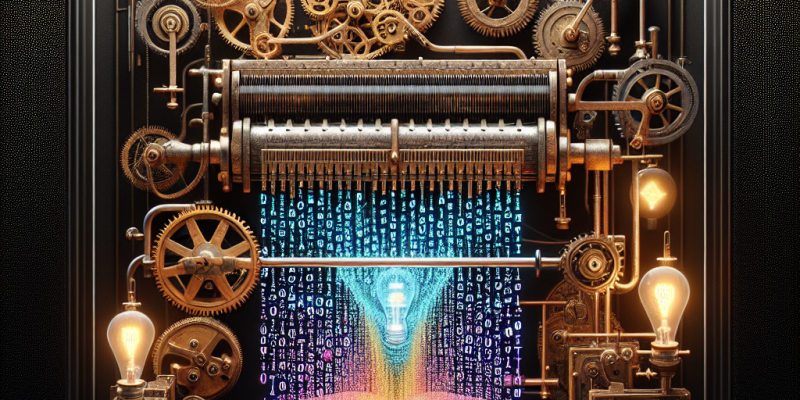From Text to Image: The Fascinating Evolution of Generative AI Techniques

The realm of artificial intelligence has witnessed remarkable advancements over the past decade, and one of the most transformative areas of research is generative AI. The ability to create images from textual descriptions has not only captured the public’s imagination but has also led to practical applications across various industries. This article explores the evolution of generative AI techniques that allow us to turn text into stunning visual representations.
The Genesis of Generative AI
Generative AI has its roots in machine learning, where algorithms are trained to understand and generate content. Initially, the focus was primarily on text generation, with models like RNNs (Recurrent Neural Networks) and LSTMs (Long Short-Term Memory networks) helping to create coherent narrative text. The deeper connection between text and images began to emerge with the development of advanced neural networks.
The Rise of GANs
Generative Adversarial Networks (GANs), introduced by Ian Goodfellow in 2014, marked a significant milestone. GANs consist of two neural networks—a generator and a discriminator—that engage in a constant game against each other. The generator creates new data instances, while the discriminator evaluates their authenticity. This iterative competition enables the generator to produce increasingly realistic images over time.
Bridging Text and Image
The next logical step was to connect textual information with visual outputs. Early experiments focused on simple domain-specific tasks, where AI could visualize objects based on specific descriptors. For example, researchers trained models to generate images for “a red apple” or “a blue car.” However, the results were often rudimentary and lacked the richness that we associate with visual art.
The Emergence of Text-to-Image Models
VQGAN and CLIP
The advent of models like VQGAN (Vector Quantized Generative Adversarial Network) combined with OpenAI’s CLIP (Contrastive Language-Image Pre-training) opened new avenues. VQGAN was capable of creating remarkably detailed images through a process called vector quantization, while CLIP served to bridge the gap between text and images. CLIP’s robust understanding of both modalities allowed it to guide VQGAN in creating images that closely matched textual descriptions, leading to striking and often surreal results.
DALL-E and Its Successors
In early 2021, OpenAI introduced DALL-E, a revolutionary model that could generate sophisticated images from text prompts. Named playfully after the artist Salvador Dalí and the animated character WALL-E, DALL-E showcased the potential of combining extensive datasets with neural networks to create images that not only adhered to the text but also displayed creativity and originality. This paved the way for subsequent models like DALL-E 2, which further refined image quality and control.
Midjourney and Stable Diffusion
Following DALL-E’s success, other platforms emerged, such as Midjourney and Stable Diffusion. Midjourney offers an interactive platform where users can generate art through simple commands, empowering amateur artists and creators. Stable Diffusion, on the other hand, emphasized accessibility by enabling users to run models locally, democratizing the use of generative AI technologies.
Applications of Generative AI in Various Sectors
The implications of turning text into images extend across numerous sectors:
Marketing and Advertising
Brands leverage generative models to create bespoke advertising visuals tailored to specific campaigns. Instead of relying on stock images, companies can generate unique content that resonates with their target audience.
Entertainment and Media
In the film and gaming industries, generative AI is revolutionizing the design process. Concept artists can quickly visualize ideas, leading to more streamlined production timelines and creative brainstorming sessions.
Education and Training
Generative AI can create customized illustrations for educational materials, helping to bring complex concepts to life. This capability fosters a more engaging learning environment, particularly in fields like science and history.
Art and Design
Artists are exploring new realms of creativity by collaborating with AI tools. Generative art, once a niche, has become mainstream, with many artists using these tools to augment their creative processes, leading to innovative works that push traditional boundaries.
Ethical Considerations and Challenges
Despite these advancements, the rise of generative AI poses several ethical questions. Issues of copyright, misinformation, and the potential for generating harmful content are significant concerns that researchers and developers must address. Ensuring that these tools are used responsibly will be crucial as they continue to develop and integrate into society.
Conclusion
The evolution from text to image using generative AI techniques illustrates a groundbreaking shift in how we interact with technology. As models continue to improve in quality and accessibility, the potential applications are limitless. From art and entertainment to education and beyond, generative AI is reshaping creativity and innovation in profound ways. While we embrace these advancements, it is equally important to navigate the ethical complexities they introduce, ensuring that the future of AI remains aligned with the values of responsibility and creativity.














